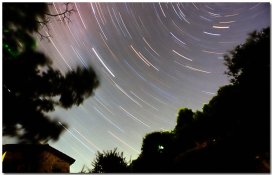Star trails in B&W
I've done a few, including a couple with FP4 which I believe suffers even more from reciprocity failure. In effect, reciprocity failure can actually help you by combating the background sky glow from light polution. The stars themselves are actually quite bright. However, for the person trying this tonight under a full moon: forget it. You need a dark sky.
A stop or two from full open is good, f/11 is probably too closed and you will lose most of the fainter stars.
Another tip is a red filter can actually help reduce the light polution from artificial illumination, seeing you're using B&W film.
Also, as Helen has said, focus is not as obvious as it seems at first. If you are using 35mm lenses, know that they usually focus quite a bit beyond infinity, and you won't see a darn difference in the view finder unless you have some serious magnification. (Tip: Google for "Hartman Mask" to construct a quick and dirty focusing aid)
Final piece of advice: tripping the shutter, and then going inside to wait out the two hour exposure usually ends up with you waking up on the couch... around 10 AM. Shutter still open of course.
Murphy's corollary to the above tip: Any cloudless clear night will immediately turn into a biblical deluge and/or hurricane Katrina the second you fall asleep.
Murphy's second corollary to the first corollary: if nothing else screws up, you haven't yet discovered what refraction does with dew.
Argh... have fun! You'll rip your hair out.


 )
)
 )
)
